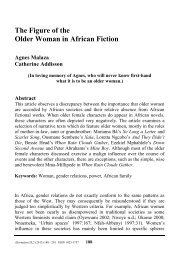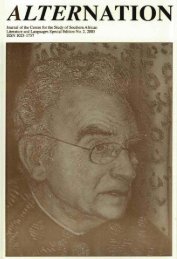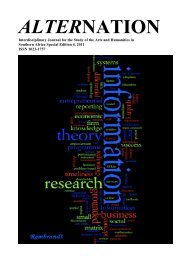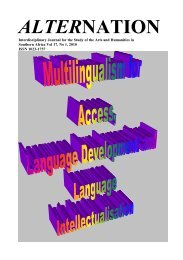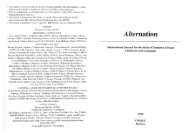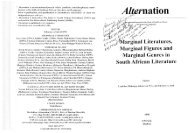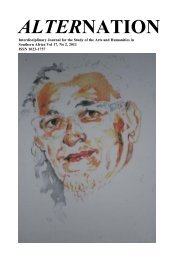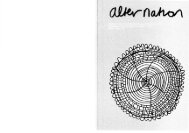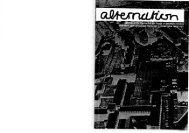Re-reading The Purloined Letter - Alternation Journal
Re-reading The Purloined Letter - Alternation Journal
Re-reading The Purloined Letter - Alternation Journal
Create successful ePaper yourself
Turn your PDF publications into a flip-book with our unique Google optimized e-Paper software.
389<br />
<strong>Re</strong>-<strong>reading</strong> <strong>The</strong> <strong>Purloined</strong> <strong>Letter</strong><br />
moving the family form, unchanged, into the future and the next moment (for<br />
Hegel, the moment of synthesis or resolution of a dialectic forms the first<br />
‘thetic’ moment of the next dialectical phase).<br />
Johnson (1980:122) states that the child’s desire thus acts as a<br />
totalizing moment of incorporation rather than a sign of difference. At the<br />
moment at which he learns of the substitution involved in signification, he<br />
consolidates a family structure articulated by Lacan—in Johnson’s<br />
(1980:122) words: ‘within the bounds of the type of ‘logocentrism’ that has<br />
been the focus of Derrida’s entire deconstructive enterprise’. <strong>The</strong> question<br />
is: what does all this have to do with <strong>The</strong> <strong>Purloined</strong> <strong>Letter</strong>? <strong>The</strong>re are two<br />
ways of answering this which have particular pertinence here. One of<br />
Johnson’s arguments is that Derrida reads the first pattern of triangulation<br />
which Lacan identifies in the Poe story (its primal scene, involving the King,<br />
the Queen and the Minister) as both a straight translation of Freudian<br />
Oedipality and as only dialectically connected to the second triad, the<br />
resolving repetition (involving the Queen, the Minister and Dupin). <strong>The</strong><br />
triangle, Johnson (1980:119f) writes:<br />
becomes the magical, Oedipal figure that explains the functioning of<br />
human desire. <strong>The</strong> child’s original imaginary dual unity with the<br />
mother is subverted by the law of the father as that which prohibits<br />
incest under threat of castration. <strong>The</strong> child has ‘simply’ to ‘assume<br />
castration’ as the necessity of substitution in the object of his desire<br />
(the object of desire becoming the locus of substitution and the focus<br />
of repetition), after which the child’s desire becomes ‘normalized’.<br />
Derrida’s criticism of the ‘triangles’ or ‘triads’ in Lacan’s <strong>reading</strong> of<br />
Poe is based on the assumption that Lacan’s use of triangularity<br />
stems from this psychoanalytic myth.<br />
For Johnson (1980:125) Derrida fails to see the repetition in Lacan’s<br />
<strong>reading</strong>. <strong>The</strong>se triads do not add up to one grand Oedipal narrative, but need<br />
to be read as interconnected but different moments. Lacan’s final model is<br />
here quadrangular—the shape of the triangles placed together, with one a<br />
repetition (with a difference) of the other—but, Johnson (1980:125) argues,<br />
it is Derrida who is blind to this. Derrida, in short does not see the<br />
difference.



